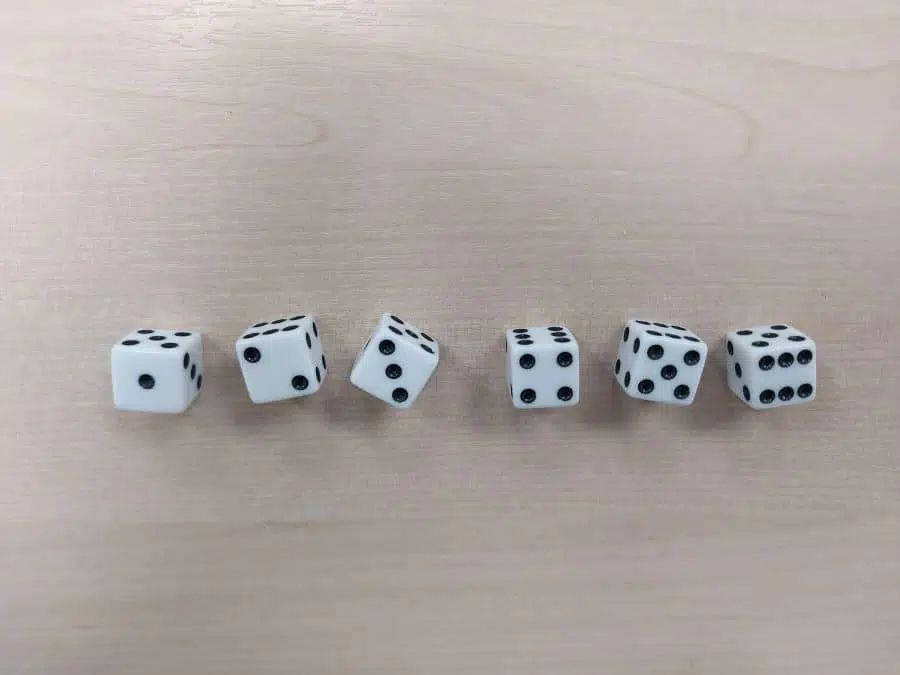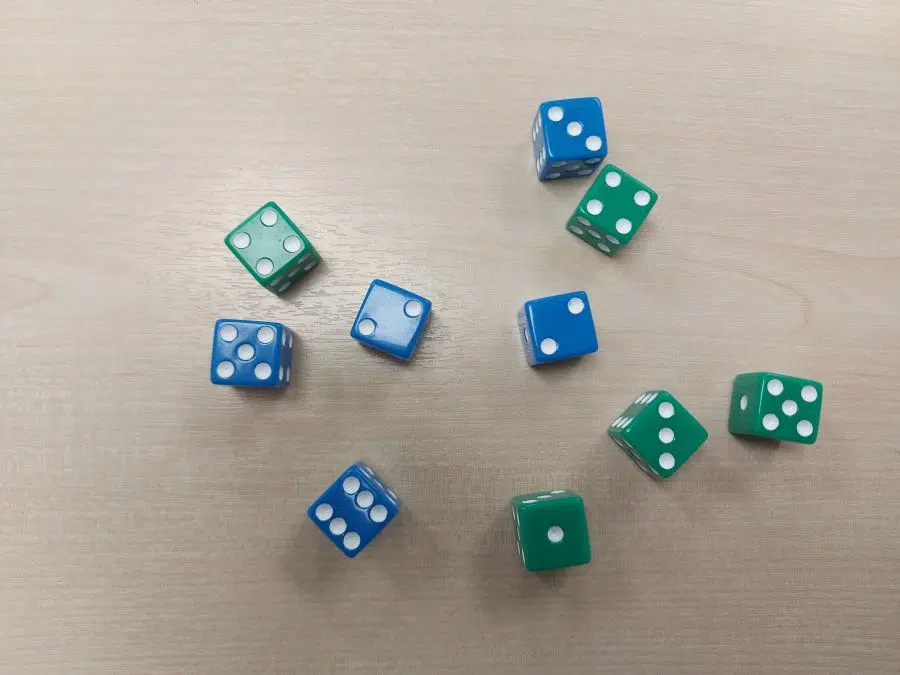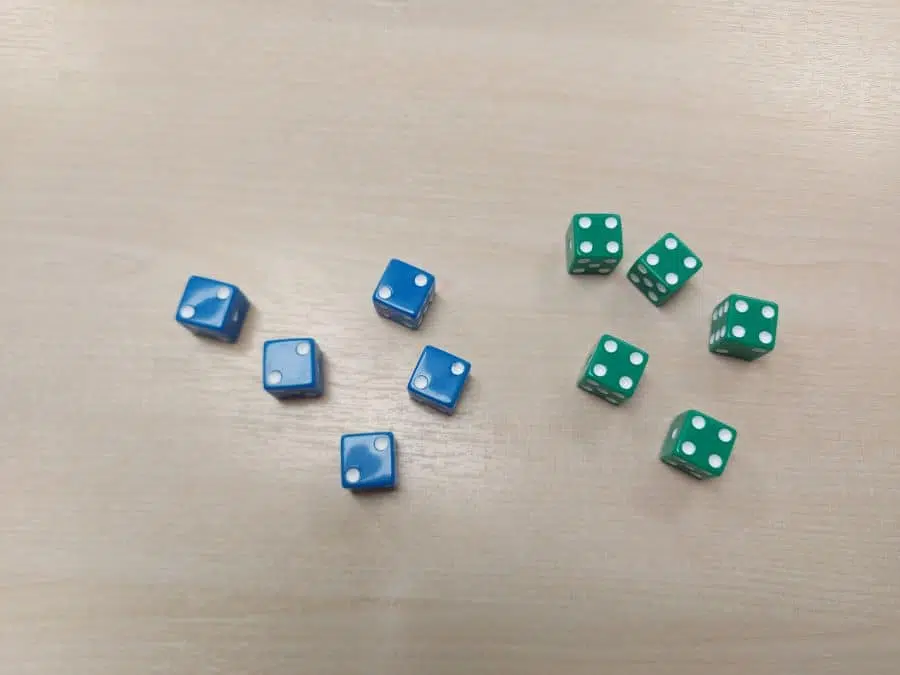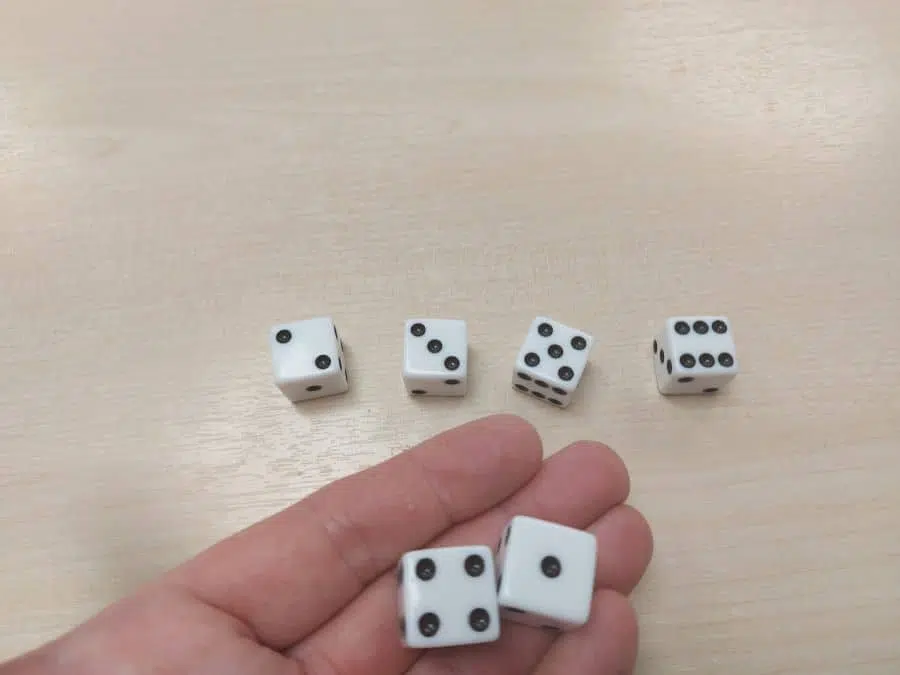Left Center Right is one of the most popular dice games on the market, and there are lots of similar games you can play.
These fall into two categories:
- Shop-bought games that are similar to Left Center Right
- DIY games that are similar to Left Center Right (and all you need are a few dice to get started)
In this post, I’ll take a look at my favorite 4 shop-bought games, and my favorite 7 DIY dice games.

4 Shop-Bought Games Like Left Center Right
1.Tenzi Dice Party Game
This is one of the most popular dice games on the market and is a rare dice game with ten dice per player.
Each player rolls their set of ten dice to start with. They will then select a ‘target’ number from what they have rolled. This will be the number they have rolled the most.
So, if you roll three 4s, then your target number will be 4.
Players put aside any of their dice that they have rolled with their target number.
Then someone says, ‘Go!’ From now on it is a race. Each player is going to roll their dice, trying to roll the target number.
Whenever you roll that number, remove that dice, and add it to your pile.
The winner is the person that gets all ten dice removed first, and shouts, ‘Tenzi!’
One great feature of the game is that it comes with a manual that explains how to play lots of different variations of the game using the same simple resources.
Here’s a video that talks you through how to play Tenzi:
2. Play Monster Farkle
Farkle is a pretty well know dice game using 6 dice. It’s been around for a very long time, and Monster Farkle is the shop-bought version of this game.
This is probably the most complex game out of all of them on this list (just to warn you). But it also has probably the most tactics, so can be very addictive when you get into it.
The basic idea is that you have 6 dice. You are going to roll the dice and try to score points.
There’s quite a long scoring system, but as an example, here are what some combinations are worth in the game:
1 is worth 100
3 of a kind – worth 100 times the face value of the dice
4 of a kind – 1000 points
3 pairs – 1500 points
This is just a snapshot, but it will give you a feel for what’s going on.
The idea is that one player rolls the six dice first. They can then keep any dice they have rolled, and use it towards scoring, or they can re-throw any dice they choose up to two more times.
At the end of the three throws, you add up what that player scored.
Play several rounds, and then see who is the winner.
A ‘farkle’, just for the record, is a round in the game where you score zero points – so one to avoid!
3. Mukikim The Genius Square
This is quite a fast-paced game. It utilizes dice, pieces, and grids on a board.
The game consists of rounds, each of which are quick in pace.
This is a great game for all ages and definitely one that stays fresh however many times you play it.
4. Gamewright Qwixx
Players – 2-5
If speed is your thing, then this game is the one for you. (There’s a clue in the name, right?)
This game is a fantastic cross between bingo and dice rolling.
It’s all about crossing off numbers in grids, strategy, and rolling the right numbers at the right time.
You can check out a full demo of how to play the game here:
7 DIY Games Like Left Center Right
1. Dice War
Resources – 6 dice each, plus a timer
Number of players – 2 to 6
For this game, each player starts with 6 dice. Agree on a time limit for the game. I would suggest 5 minutes to begin with.
Start the timer, and every player rolls one of their dice. The player with the highest number wins that round, and they take all the dice.
If there are two or more of the same high number, then that round is a draw. You must have just one number being the champion each time.
Keep going until the time limit is up. At that point, whoever has the most dice is the winner.
You can also play the version where there is no time limit, but you just play until one player has all the dice.
2. Higher or Lower
Resources – 6 dice each per player
Players – 2
The two players sit facing each other. Each player has six dice, and the first player rolls just one of their dice.
The player next to them will call either ‘higher’ or ‘lower’, and then roll their dice. If they are correct, then they win the two dice. If they are incorrect, then the first player receives both dice.
As an example, the first player rolls a 5, and the second player calls ‘lower’. They roll their dice and get a 2.
As this is indeed lower than 5, the second player wins and takes both dice.
The winner of the previous round rolls first in the next round.
The game is over either:
- When one player has won all the dice
- After an agreed time limit, for example, 5 minutes. After this, whoever has the most dice has won.
3. Two Fives!
Resources – sets of ten dice for each player – 5 of one color and 5 of another.
Number of players – 2-10+
This game is a bit like Tenzi, only you split the dice into two.
Every player has ten dice. They have five of one color, and five of the other. Start by everyone rolling their ten dice in front of them.
The players will all now pick two target numbers. These will be two numbers that are showing more than others from the dice they have just rolled.
As an example – on your blue dice you might roll two 2s, and on your green dice two 4s. Just like this:

Great! Your target numbers will be 2 and 4. The players remove these dice from their set, and put them to one side.
Then someone says, ‘Go!’
From now on it is a game of speed! The players must roll their remaining dice rapidly, trying to roll their target numbers on the colors of dice. You are aiming to get 5 lots of one target number on one color of dice, and 5 lots of the other target number on the other color.
The winner is the first person to get two lots of five.

4. Knock Out
Resources – 1 dice per player
Number of Players – 2-6
This is a simple game of attrition.
Sit in a circle, and first agree what the ‘knock-out’ number will be. Do this by one person rolling a dice, and seeing what they get. That is the target number.
Then, one at a time, going round the circle, each player rolls their one dice. If they get the knock-out number they are out!
If not, they are still in.
The winner is the last person standing at the end
5. Target Dice
Resources – 2 dice per player, a pencil and piece of paper to keep score, a timer
Players – 2 – 6
This is similar to the ‘knock-out’ game but slightly longer and more complex.
To start with, one player rolls just one dice, and this becomes the ‘target’ number.
Then the person next to them starts. They roll both dice, trying to roll the ‘target’ number.
It is a points-scoring game, with points awarded like this:
Roll the target number with 1 dice – 1 point
Roll the target number with 2 dice – 3 points
Make a note of your score every time you roll.
You can play until:
- One player reaches a score, such as 20, and becomes the winner
- You reach the end of a pre-agreed time limit, such as 5 minutes. Whoever then has the most points is the champion.
6. Run Magic
Resources – 6 dice per player
Players – 2-10+
This is a game of speed and multiple rolls in a short time period.
Each player starts with 6 dice, and one player says, ‘Go!’
The players will roll their 6 dice. They are aiming to get a run of 1 to 6.
They can save dice out of the ones they roll and just roll the remaining ones again.
So, as an example, if you roll 2, 2, 3, 5, 5, 6, then you could keep the 2, 3, 5, and 6 as part of your run. It would look a bit like this:

You would then just roll the two remaining dice until you could roll a 1 and 4.
The first person to have 1 to 6 in order is the winner.
7. 50 Up
Resources – Piece of paper and pen, 6 dice each
Number of players – 2-6
The idea of this game is to get long runs of consecutive numbers.
Players take roll their six dice at the same time. They see if they have any consecutive runs. For example, they might roll 2, 3, 4 or 1, 2, 3, 4.
The winner of each round is the person with the longest run. You then get points for the quantity of numbers in your run.
So you would get 4 points for a run of 4 (such as 2, 3, 4, 5), or 3 points for a run of 3 (such as 4, 5, 6).
If there is a tie, then both the leading players get points.
Write down the scores. The first person to get to 50 is the champion.
